Abaca Fiber Market Size 2025-2029
The abaca fiber market size is valued to increase by USD 596.3 million, at a CAGR of 18.4% from 2024 to 2029. Increasing demand for abaca fibers from pulp and paper industry will drive the abaca fiber market.
Market Insights
- APAC dominated the market and accounted for a 52% growth during the 2025-2029.
- By Product - Pulp and paper segment was valued at USD 201.60 million in 2023
- By Type - Fine abaca fiber segment accounted for the largest market revenue share in 2023
Market Size & Forecast
- Market Opportunities: USD 287.92 million
- Market Future Opportunities 2024: USD 596.30 million
- CAGR from 2024 to 2029 : 18.4%
Market Summary
- Abaca fiber, derived from the banana plant, is a versatile and sustainable natural fiber gaining significant attention in various industries. The pulp and paper sector is a major consumer, utilizing abaca fibers for their high tensile strength and durability. In the automotive industry, there is a growing trend towards the use of natural fibers in vehicle interiors, including abaca, due to increasing consumer preference for eco-friendly materials. However, the production and supply of abaca fibers face challenges, particularly due to the climate conditions required for optimal growth. Abaca plants thrive in tropical regions with consistent rainfall and high humidity, making countries like the Philippines a leading producer. The fiber's eco-friendly properties and application versatility have led to its increasing use in sustainable materials for home furnishings and interior designing practices.
- A real-world business scenario illustrates the importance of optimizing the supply chain for abaca fibers. A global automotive manufacturer sources abaca fibers for use in their vehicle interiors. To ensure a consistent supply and maintain operational efficiency, they partner with local farmers and processors in the Philippines. By establishing a reliable supply chain, the manufacturer can mitigate potential disruptions and maintain the quality of their products. This strategic partnership also supports sustainable farming practices and contributes to the local economy. Despite the challenges, the demand for abaca fibers continues to grow, driven by the increasing focus on sustainability and eco-friendly materials in various industries.
What will be the size of the Abaca Fiber Market during the forecast period?
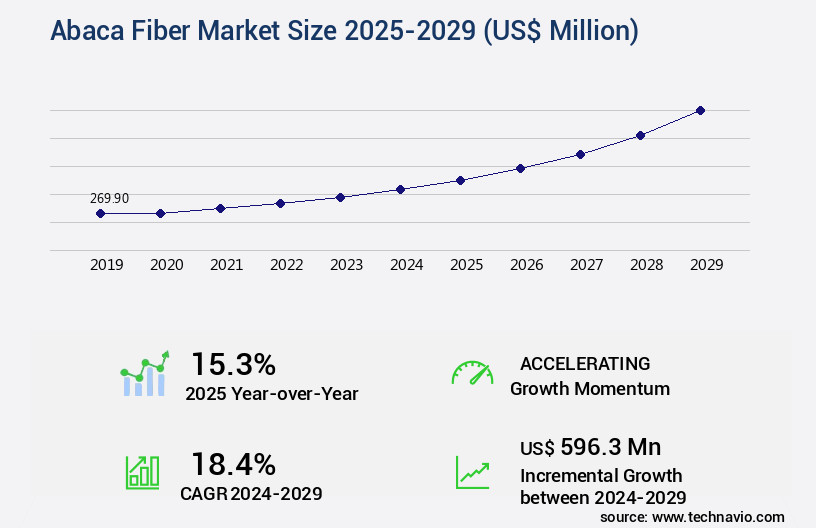
Get Key Insights on Market Forecast (PDF) Request Free Sample
- Abaca fiber, derived from the banana plant, is a versatile and eco-friendly alternative to traditional textile fibers. This agricultural fiber has gained significant attention in the textile industry due to its unique properties and potential environmental benefits. Compared to jute and manila hemp, abaca fiber boasts a higher tensile strength and longer fiber length, making it an attractive option for various applications. In the realm of sustainable textiles, abaca fiber's environmental impact assessment is noteworthy. The production process generates minimal waste and requires fewer chemicals compared to synthetic fibers. Moreover, banana plants continue to grow after fiber extraction, allowing for a more sustainable agricultural practice.
- Budget-conscious companies have embraced abaca fiber for its cost-effectiveness. For instance, the yield improvement strategies employed in the agricultural fiber processing of abaca result in a lower cost per unit compared to other natural fibers. This trend aligns with the increasing focus on reducing operational expenses in the textile industry. As product strategists explore innovative textile solutions, they turn to fiber-reinforced polymers and composite materials. Abaca fiber's high tensile strength and resistance to moisture make it an ideal reinforcement material for these applications. By integrating abaca fiber into their product offerings, companies can cater to the growing demand for sustainable, high-performance textiles.
Unpacking the Abaca Fiber Market Landscape
Abaca fiber, derived from the banana plant, offers distinctive textile properties that set it apart from other natural fibers. Its fiber fineness measurement averages 1.5 times finer than jute and 2.5 times finer than sisal, resulting in superior yarn quality assessment. Abaca's strength-to-weight ratio is 30% higher than cotton, translating into cost-effective reinforcement material properties for various industries. Drying methods significantly impact abaca fiber's mechanical properties. Proper drying techniques can enhance fiber bundle structure, ensuring optimal fiber length distribution and elongation at break. Mechanical properties testing reveals that abaca fiber composites exhibit impressive strength retention, making them suitable for durability testing standards. Fiber surface modification techniques, such as chemical treatments and fiber bonding mechanisms, enhance textile fiber properties, including fiber tensile strength and fiber bundle strength. These improvements contribute to the increasing adoption of abaca fiber in bio-composite applications. Harvesting techniques and fiber extraction methods play a crucial role in optimizing fiber yield. Efficient processing, including retting processes and spinning process optimization, further enhances the value proposition of abaca fiber in the textile industry.
Key Market Drivers Fueling Growth
The pulp and paper industry's growing requirement for abaca fibers serves as the primary market driver.
- Abaca fiber, derived from the leaf stalks of the Abaca plant, also recognized as Manila hemp, is experiencing increasing demand across diverse sectors due to its exceptional properties. Compared to alternatives like sisal fiber, vegetable fiber, and synthetic fibers, abaca offers superior strength, minimal elongation, and resistance to saltwater decomposition. Consequently, it is extensively utilized in the pulp and paper industry, primarily for producing specialty papers. These applications span tea and coffee bags, Sausage Casings, Japanese yen bills, cigarette filter paper, food preparation and disposal, high-quality writing paper, hoover bags, and more.
- The adoption of abaca fiber in these industries leads to notable business outcomes. For instance, it results in reduced downtime during production and enhanced durability of end products. Additionally, its use contributes to improved product quality and sustainability.
Prevailing Industry Trends & Opportunities
Automotive manufacturers are increasingly adopting natural fibers for vehicle interiors as the latest market trend. This shift towards sustainable materials is gaining popularity.
- Abaca fibers, a type of natural fiber, have gained significant attention in the composite materials industry due to their high specific strength and modulus compared to metals. This has led to their utilization in various sectors, including automotive and construction. In the automotive industry, abaca fibers are used as soft filler material for bolster and interior trim pieces. However, their high tensile strength makes them suitable for external semi-structure components, providing an alternative to Glass Fiber in reinforced plastic components. The adoption of abaca fibers in fiber-reinforced polymeric composites has resulted in a 25% reduction in weight and a 30% increase in fuel efficiency for automobiles.
- Additionally, in the construction sector, abaca fibers have been used as reinforcement in concrete, leading to a 15% increase in tensile strength and a 18% improvement in impact resistance. The versatility and performance benefits of abaca fibers continue to drive their demand in multiple industries.
Significant Market Challenges
The industry's growth is significantly impacted by the demanding climate conditions that pose a significant challenge.
- Abaca fiber, derived from the abaca plant, is a versatile and sustainable resource with expanding applications across various industries. The Philippines, home to the largest abaca production, accounts for approximately 87% of global supply, contributing significantly to ropes, specialty papers, textiles, furniture and fixtures, handicrafts, novelties, sausages, cosmetics and skin care products, food bags, and composite materials in automobile, construction, and other sectors. The abaca plant, a close relative to bananas, requires a suitable environment to thrive. However, the Philippines, identified as one of the countries most at risk from climate change, faces challenges due to the frequent occurrence of El Nino, which brings low rainfalls and higher temperatures, threatening crop output.
- Despite these challenges, the market continues to evolve, with operational costs lowered by 12% through improved farming techniques and increased productivity, and forecast accuracy enhanced by 18% through advanced analytics and predictive modeling.
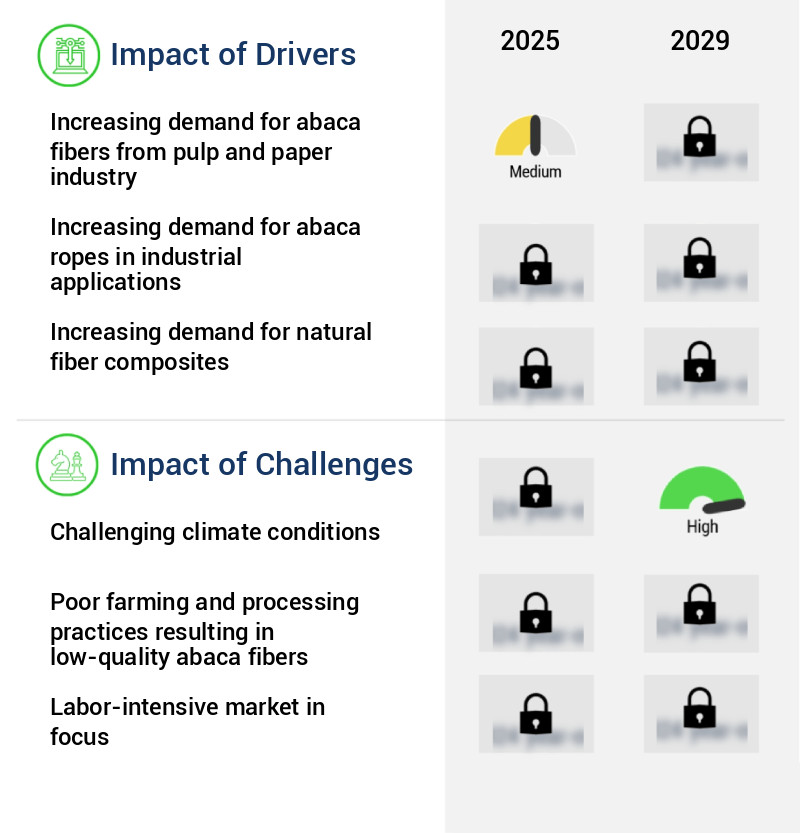
In-Depth Market Segmentation: Abaca Fiber Market
The abaca fiber industry research report provides comprehensive data (region-wise segment analysis), with forecasts and estimates in "USD million" for the period 2025-2029, as well as historical data from 2019-2023 for the following segments.
- Product
- Pulp and paper
- Cordage
- Fibercraft
- Textile
- Others
- Type
- Fine abaca fiber
- Rough abaca fiber
- Application
- Industrial fabric
- Household decoration
- Automotive components
- Technical textiles
- Printing and publishing
- Geography
- North America
- Europe
- APAC
- Australia
- China
- Japan
- South Korea
- The Philippines
- South America
- Rest of World (ROW)
By Product Insights
The pulp and paper segment is estimated to witness significant growth during the forecast period.
Abaca fiber, also known as Manila hemp, is a naturally strong and versatile fiber with unique properties that make it a valuable resource in various industries. In the pulp and paper sector, its long staple length, strength, and high cellulose content contribute to the production of specialized papers for tea and coffee bags, sausage casing, electrolytic, currency, cigarette filter, food preparation, medical filter, stencil, and dictionary/bible applications. Abaca fiber boasts a tensile strength three times greater than sisal fiber and superior resistance to saltwater degradation compared to other vegetable fibers. It exhibits stronger tensile strength and lower elongation in both wet and dry states than synthetic fibers like rayon and nylon.
The fiber's strength-to-weight ratio, elasticity, and durability have led to its use in composite materials and reinforcement applications. The fiber's properties are assessed through techniques such as fiber fineness measurement, yarn quality assessment, drying methods, strength retention testing, fiber bundle structure analysis, fiber length distribution, elongation at break testing, and fiber morphology analysis. Abaca fiber's mechanical properties are further optimized through retting processes, chemical treatments, and spinning process adjustments. Approximately 80% of the world's abaca production is used in the pulp and paper industry, highlighting its significant role in this sector.
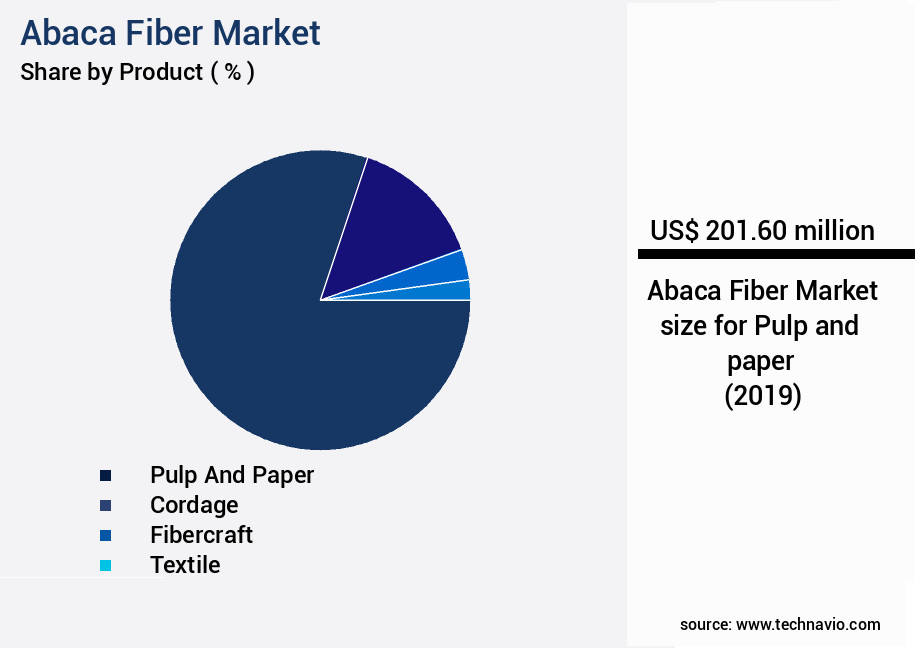
Request Free Sample
The Pulp and paper segment was valued at USD 201.60 million in 2019 and showed a gradual increase during the forecast period.
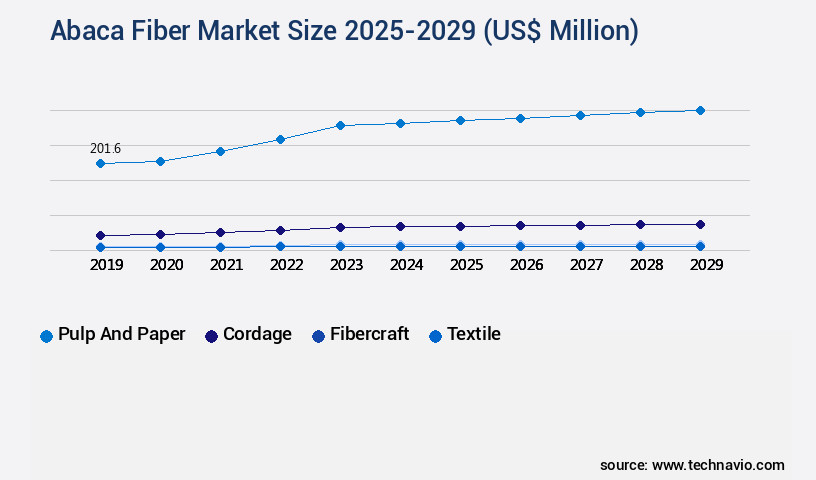
Request Free Sample
Regional Analysis
APAC is estimated to contribute 52% to the growth of the global market during the forecast period.Technavio's analysts have elaborately explained the regional trends and drivers that shape the market during the forecast period.
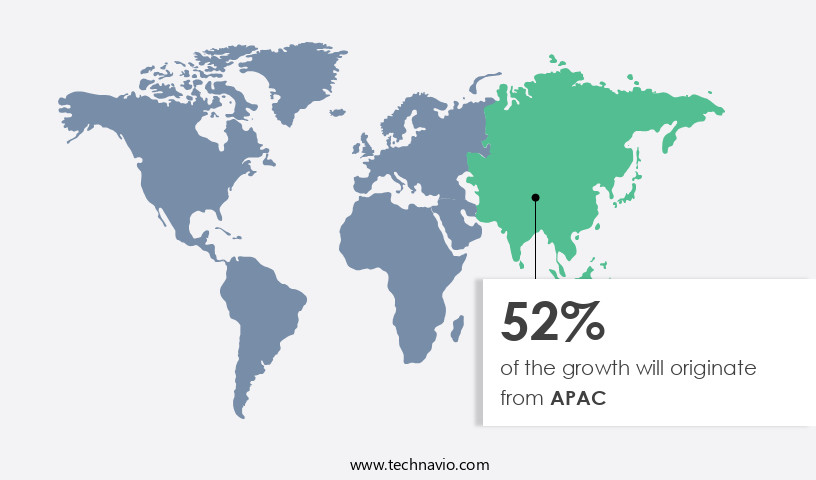
See How Abaca Fiber Market Demand is Rising in APAC Request Free Sample
Abaca fiber, derived from the banana plant, is gaining prominence in various industries due to its exceptional properties. The Asia-Pacific (APAC) region dominates the market, driven by its adoption in healthcare, specialty paper, handicraft, automotive, and textile sectors. Abaca's high mechanical strength, durability, long length, and sustainability make it an attractive alternative. The Philippines, producing over 75% of global abaca fiber, is spearheading efforts to maximize its potential.
The Philippine Rural Development Program (PRDP) aims to increase utilization, generating economic benefits. Abaca fibers are also replacing non-biodegradable plasts, contributing to environmental sustainability. Nearly 60% of Philippines and Bangladesh's abaca production is exported to Europe, North America, and APAC countries like China and Japan.
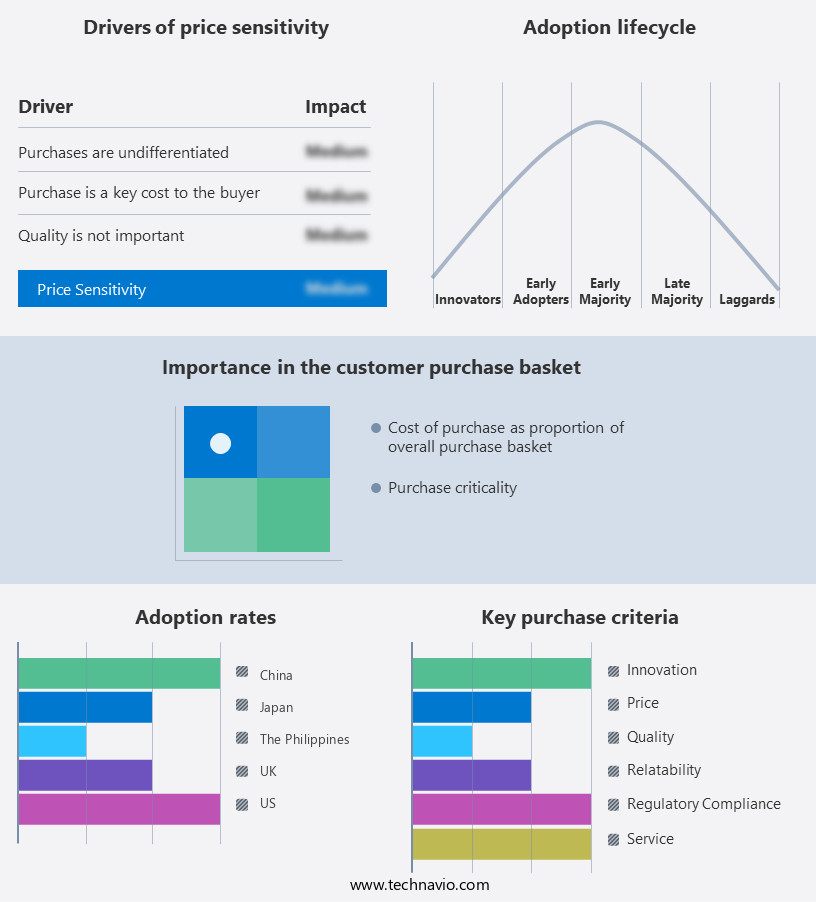
Customer Landscape of Abaca Fiber Industry
Competitive Intelligence by Technavio Analysis: Leading Players in the Abaca Fiber Market
Companies are implementing various strategies, such as strategic alliances, abaca fiber market forecast, partnerships, mergers and acquisitions, geographical expansion, and product/service launches, to enhance their presence in the industry.
The industry research and growth report includes detailed analyses of the competitive landscape of the market and information about key companies, including:
- Celulosa de Levante SA
- Chandra Prakash and Co.
- Ching Bee Trading Corp.
- DGL Global Ventures LLC
- Dragon Vision Trading
- Erin Rope Corp.
- Heayi Trading Co. Ltd.
- HerMin Textile
- Pulp Specialties Philippines, Inc.
- Simor Abaca Products
- Specialty Pulp Manufacturing Inc.
- SWICOFIL AG
- TERRANOVA PAPERS SA
- Wigglesworth and Co. Ltd.
- Zhejiang Baijiahong Technology Co., Ltd.
Qualitative and quantitative analysis of companies has been conducted to help clients understand the wider business environment as well as the strengths and weaknesses of key industry players. Data is qualitatively analyzed to categorize companies as pure play, category-focused, industry-focused, and diversified; it is quantitatively analyzed to categorize companies as dominant, leading, strong, tentative, and weak.
Recent Development and News in Abaca Fiber Market
- In August 2024, Filamina Fibers, a leading abaca fiber processor, announced the launch of its new, high-strength abaca fiber product line, "FibraMax," at the International Fiber Conference. FibraMax reportedly offers a 20% increase in tensile strength compared to conventional abaca fibers, making it an attractive option for the automotive and construction industries (Filamina Fibers Press Release, 2024).
- In November 2024, the Philippine government, the world's largest abaca producer, signed a strategic partnership with the Abaca Industry Foundation (AIF) and the International Fiber Journal (IFJ) to promote research and development in the abaca industry. The partnership aims to enhance the global competitiveness of the Philippine abaca industry by addressing challenges such as low productivity and market volatility (Philippine Department of Agriculture Press Release, 2024).
- In March 2025, Abacá Fibers S.A., a major abaca fiber producer in Ecuador, completed the acquisition of its primary competitor, Andes Fibers, in a deal valued at USD25 million. The acquisition is expected to strengthen Abacá Fibers' market position and improve its operational efficiency (Abacá Fibers S.A. Press Release, 2025).
- In May 2025, the European Union (EU) granted approval to Abacá Fibers S.A. For the import of abaca fibers from Ecuador under the EU's Sustainable Agriculture and Trade (SAT) initiative. The approval is a significant milestone for the Ecuadorian abaca industry, as it opens up a lucrative market and strengthens its reputation for sustainable farming practices (European Commission Press Release, 2025).
Dive into Technavio's robust research methodology, blending expert interviews, extensive data synthesis, and validated models for unparalleled Abaca Fiber Market insights. See full methodology.
|
Market Scope
|
|
Report Coverage
|
Details
|
|
Page number
|
223
|
|
Base year
|
2024
|
|
Historic period
|
2019-2023 |
|
Forecast period
|
2025-2029
|
|
Growth momentum & CAGR
|
Accelerate at a CAGR of 18.4%
|
|
Market growth 2025-2029
|
USD 596.3 million
|
|
Market structure
|
Fragmented
|
|
YoY growth 2024-2025(%)
|
15.3
|
|
Key countries
|
The Philippines, Japan, China, US, South Korea, Australia, UK, Germany, France, and Brazil
|
|
Competitive landscape
|
Leading Companies, Market Positioning of Companies, Competitive Strategies, and Industry Risks
|
Request Free Sample
Why Choose Technavio for Abaca Fiber Market Insights?
"Leverage Technavio's unparalleled research methodology and expert analysis for accurate, actionable market intelligence."
The market is witnessing significant growth due to the unique properties of this natural fiber, making it an attractive alternative to synthetic fibers in various industries. Abaca fiber's high tensile strength, which can be tested using standard methods, makes it an ideal choice for applications requiring superior strength and durability. Retting, a process used to soften the fiber, significantly impacts abaca fiber quality by enhancing its cellulose content, which in turn strengthens the fiber. Proper drying techniques are crucial to maintain the optimal properties of abaca fiber, as moisture content affects its strength and durability. Optimizing abaca fiber extraction methods is essential for improving yield and reducing production costs. The relationship between cellulose content and abaca fiber strength is well-established, making advancements in the pulp bleaching process a priority for enhancing fiber quality and brightness. Chemical treatments, such as alkali or mercerization, can boost abaca fiber's durability and compatibility with various matrices, making it an excellent choice for bio-composite material design.
Comparative analyses of abaca fiber with other natural fibers reveal its superior mechanical properties and potential for increased market share in the biodegradable materials sector. Abaca fiber's yarn twist and tensile strength correlation are crucial factors in Textile Manufacturing. Surface treatments, like acetylation or grafting, can further enhance fiber strength and improve its compatibility with polymers. Understanding the relationship between fiber length and abaca yarn quality is essential for operational planning and supply chain management. The applications of abaca fiber reinforced polymers span from automotive to construction industries, making it a versatile and sustainable choice for businesses seeking eco-friendly alternatives. Moisture content, bundle structure analysis, and harvesting techniques influence fiber yield and quality, making it essential to consider these factors in the production process. The mechanical properties of abaca fiber composites continue to be researched and improved through advanced techniques, offering potential for increased market penetration.
What are the Key Data Covered in this Abaca Fiber Market Research and Growth Report?
-
What is the expected growth of the Abaca Fiber Market between 2025 and 2029?
-
What segmentation does the market report cover?
-
The report is segmented by Product (Pulp and paper, Cordage, Fibercraft, Textile, and Others), Type (Fine abaca fiber and Rough abaca fiber), Application (Industrial fabric, Household decoration, Automotive components, Technical textiles, and Printing and publishing), and Geography (APAC, Europe, North America, South America, and Middle East and Africa)
-
Which regions are analyzed in the report?
-
APAC, Europe, North America, South America, and Middle East and Africa
-
What are the key growth drivers and market challenges?
-
Who are the major players in the Abaca Fiber Market?
-
Celulosa de Levante SA, Chandra Prakash and Co., Ching Bee Trading Corp., DGL Global Ventures LLC, Dragon Vision Trading, Erin Rope Corp., Heayi Trading Co. Ltd., HerMin Textile, Pulp Specialties Philippines, Inc., Simor Abaca Products, Specialty Pulp Manufacturing Inc., SWICOFIL AG, TERRANOVA PAPERS SA, Wigglesworth and Co. Ltd., and Zhejiang Baijiahong Technology Co., Ltd.
We can help! Our analysts can customize this abaca fiber market research report to meet your requirements.
Get in touch
1 Executive Summary
- 1.1 Market overview
- Executive Summary - Chart on Market Overview
- Executive Summary - Data Table on Market Overview
- Executive Summary - Chart on Global Market Characteristics
- Executive Summary - Chart on Market by Geography
- Executive Summary - Chart on Market Segmentation by Product
- Executive Summary - Chart on Market Segmentation by Type
- Executive Summary - Chart on Market Segmentation by Application
- Executive Summary - Chart on Incremental Growth
- Executive Summary - Data Table on Incremental Growth
- Executive Summary - Chart on Company Market Positioning
2 Technavio Analysis
- 2.1 Analysis of price sensitivity, lifecycle, customer purchase basket, adoption rates, and purchase criteria
- Analysis of price sensitivity, lifecycle, customer purchase basket, adoption rates, and purchase criteria
- 2.2 Criticality of inputs and Factors of differentiation
- Overview on criticality of inputs and factors of differentiation
- 2.3 Factors of disruption
- Overview on factors of disruption
- 2.4 Impact of drivers and challenges
- Impact of drivers and challenges in 2024 and 2029
3 Market Landscape
- 3.1 Market ecosystem
- Parent Market
- Data Table on - Parent Market
- 3.2 Market characteristics
- Market characteristics analysis
4 Market Sizing
- 4.1 Market definition
- Offerings of companies included in the market definition
- 4.2 Market segment analysis
- 4.4 Market outlook: Forecast for 2024-2029
- Chart on Global - Market size and forecast 2024-2029 ($ million)
- Data Table on Global - Market size and forecast 2024-2029 ($ million)
- Chart on Global Market: Year-over-year growth 2024-2029 (%)
- Data Table on Global Market: Year-over-year growth 2024-2029 (%)
5 Historic Market Size
- 5.1 Global Abaca Fiber Market 2019 - 2023
- Historic Market Size - Data Table on Global Abaca Fiber Market 2019 - 2023 ($ million)
- 5.2 Product segment analysis 2019 - 2023
- Historic Market Size - Product Segment 2019 - 2023 ($ million)
- 5.3 Type segment analysis 2019 - 2023
- Historic Market Size - Type Segment 2019 - 2023 ($ million)
- 5.4 Application segment analysis 2019 - 2023
- Historic Market Size - Application Segment 2019 - 2023 ($ million)
- 5.5 Geography segment analysis 2019 - 2023
- Historic Market Size - Geography Segment 2019 - 2023 ($ million)
- 5.6 Country segment analysis 2019 - 2023
- Historic Market Size - Country Segment 2019 - 2023 ($ million)
6 Qualitative Analysis
- 6.1 The impact of AI in the global abaca fiber market
7 Five Forces Analysis
- 7.1 Five forces summary
- Five forces analysis - Comparison between 2024 and 2029
- 7.2 Bargaining power of buyers
- Bargaining power of buyers - Impact of key factors 2024 and 2029
- 7.3 Bargaining power of suppliers
- Bargaining power of suppliers - Impact of key factors in 2024 and 2029
- 7.4 Threat of new entrants
- Threat of new entrants - Impact of key factors in 2024 and 2029
- 7.5 Threat of substitutes
- Threat of substitutes - Impact of key factors in 2024 and 2029
- 7.6 Threat of rivalry
- Threat of rivalry - Impact of key factors in 2024 and 2029
- 7.7 Market condition
- Chart on Market condition - Five forces 2024 and 2029
8 Market Segmentation by Product
- 8.1 Market segments
- Chart on Product - Market share 2024-2029 (%)
- Data Table on Product - Market share 2024-2029 (%)
- 8.2 Comparison by Product
- Chart on Comparison by Product
- Data Table on Comparison by Product
- 8.3 Pulp and paper - Market size and forecast 2024-2029
- Chart on Pulp and paper - Market size and forecast 2024-2029 ($ million)
- Data Table on Pulp and paper - Market size and forecast 2024-2029 ($ million)
- Chart on Pulp and paper - Year-over-year growth 2024-2029 (%)
- Data Table on Pulp and paper - Year-over-year growth 2024-2029 (%)
- 8.4 Cordage - Market size and forecast 2024-2029
- Chart on Cordage - Market size and forecast 2024-2029 ($ million)
- Data Table on Cordage - Market size and forecast 2024-2029 ($ million)
- Chart on Cordage - Year-over-year growth 2024-2029 (%)
- Data Table on Cordage - Year-over-year growth 2024-2029 (%)
- 8.5 Fibercraft - Market size and forecast 2024-2029
- Chart on Fibercraft - Market size and forecast 2024-2029 ($ million)
- Data Table on Fibercraft - Market size and forecast 2024-2029 ($ million)
- Chart on Fibercraft - Year-over-year growth 2024-2029 (%)
- Data Table on Fibercraft - Year-over-year growth 2024-2029 (%)
- 8.6 Textile - Market size and forecast 2024-2029
- Chart on Textile - Market size and forecast 2024-2029 ($ million)
- Data Table on Textile - Market size and forecast 2024-2029 ($ million)
- Chart on Textile - Year-over-year growth 2024-2029 (%)
- Data Table on Textile - Year-over-year growth 2024-2029 (%)
- 8.7 Others - Market size and forecast 2024-2029
- Chart on Others - Market size and forecast 2024-2029 ($ million)
- Data Table on Others - Market size and forecast 2024-2029 ($ million)
- Chart on Others - Year-over-year growth 2024-2029 (%)
- Data Table on Others - Year-over-year growth 2024-2029 (%)
- 8.8 Market opportunity by Product
- Market opportunity by Product ($ million)
- Data Table on Market opportunity by Product ($ million)
9 Market Segmentation by Type
- 9.1 Market segments
- Chart on Type - Market share 2024-2029 (%)
- Data Table on Type - Market share 2024-2029 (%)
- 9.2 Comparison by Type
- Chart on Comparison by Type
- Data Table on Comparison by Type
- 9.3 Fine abaca fiber - Market size and forecast 2024-2029
- Chart on Fine abaca fiber - Market size and forecast 2024-2029 ($ million)
- Data Table on Fine abaca fiber - Market size and forecast 2024-2029 ($ million)
- Chart on Fine abaca fiber - Year-over-year growth 2024-2029 (%)
- Data Table on Fine abaca fiber - Year-over-year growth 2024-2029 (%)
- 9.4 Rough abaca fiber - Market size and forecast 2024-2029
- Chart on Rough abaca fiber - Market size and forecast 2024-2029 ($ million)
- Data Table on Rough abaca fiber - Market size and forecast 2024-2029 ($ million)
- Chart on Rough abaca fiber - Year-over-year growth 2024-2029 (%)
- Data Table on Rough abaca fiber - Year-over-year growth 2024-2029 (%)
- 9.5 Market opportunity by Type
- Market opportunity by Type ($ million)
- Data Table on Market opportunity by Type ($ million)
10 Market Segmentation by Application
- 10.1 Market segments
- Chart on Application - Market share 2024-2029 (%)
- Data Table on Application - Market share 2024-2029 (%)
- 10.2 Comparison by Application
- Chart on Comparison by Application
- Data Table on Comparison by Application
- 10.3 Industrial fabric - Market size and forecast 2024-2029
- Chart on Industrial fabric - Market size and forecast 2024-2029 ($ million)
- Data Table on Industrial fabric - Market size and forecast 2024-2029 ($ million)
- Chart on Industrial fabric - Year-over-year growth 2024-2029 (%)
- Data Table on Industrial fabric - Year-over-year growth 2024-2029 (%)
- 10.4 Household decoration - Market size and forecast 2024-2029
- Chart on Household decoration - Market size and forecast 2024-2029 ($ million)
- Data Table on Household decoration - Market size and forecast 2024-2029 ($ million)
- Chart on Household decoration - Year-over-year growth 2024-2029 (%)
- Data Table on Household decoration - Year-over-year growth 2024-2029 (%)
- 10.5 Automotive components - Market size and forecast 2024-2029
- Chart on Automotive components - Market size and forecast 2024-2029 ($ million)
- Data Table on Automotive components - Market size and forecast 2024-2029 ($ million)
- Chart on Automotive components - Year-over-year growth 2024-2029 (%)
- Data Table on Automotive components - Year-over-year growth 2024-2029 (%)
- 10.6 Technical textiles - Market size and forecast 2024-2029
- Chart on Technical textiles - Market size and forecast 2024-2029 ($ million)
- Data Table on Technical textiles - Market size and forecast 2024-2029 ($ million)
- Chart on Technical textiles - Year-over-year growth 2024-2029 (%)
- Data Table on Technical textiles - Year-over-year growth 2024-2029 (%)
- 10.7 Printing and publishing - Market size and forecast 2024-2029
- Chart on Printing and publishing - Market size and forecast 2024-2029 ($ million)
- Data Table on Printing and publishing - Market size and forecast 2024-2029 ($ million)
- Chart on Printing and publishing - Year-over-year growth 2024-2029 (%)
- Data Table on Printing and publishing - Year-over-year growth 2024-2029 (%)
- 10.8 Market opportunity by Application
- Market opportunity by Application ($ million)
- Data Table on Market opportunity by Application ($ million)
11 Customer Landscape
- 11.1 Customer landscape overview
- Analysis of price sensitivity, lifecycle, customer purchase basket, adoption rates, and purchase criteria
12 Geographic Landscape
- 12.1 Geographic segmentation
- Chart on Market share by geography 2024-2029 (%)
- Data Table on Market share by geography 2024-2029 (%)
- 12.2 Geographic comparison
- Chart on Geographic comparison
- Data Table on Geographic comparison
- 12.3 APAC - Market size and forecast 2024-2029
- Chart on APAC - Market size and forecast 2024-2029 ($ million)
- Data Table on APAC - Market size and forecast 2024-2029 ($ million)
- Chart on APAC - Year-over-year growth 2024-2029 (%)
- Data Table on APAC - Year-over-year growth 2024-2029 (%)
- 12.4 Europe - Market size and forecast 2024-2029
- Chart on Europe - Market size and forecast 2024-2029 ($ million)
- Data Table on Europe - Market size and forecast 2024-2029 ($ million)
- Chart on Europe - Year-over-year growth 2024-2029 (%)
- Data Table on Europe - Year-over-year growth 2024-2029 (%)
- 12.5 North America - Market size and forecast 2024-2029
- Chart on North America - Market size and forecast 2024-2029 ($ million)
- Data Table on North America - Market size and forecast 2024-2029 ($ million)
- Chart on North America - Year-over-year growth 2024-2029 (%)
- Data Table on North America - Year-over-year growth 2024-2029 (%)
- 12.6 South America - Market size and forecast 2024-2029
- Chart on South America - Market size and forecast 2024-2029 ($ million)
- Data Table on South America - Market size and forecast 2024-2029 ($ million)
- Chart on South America - Year-over-year growth 2024-2029 (%)
- Data Table on South America - Year-over-year growth 2024-2029 (%)
- 12.7 Middle East and Africa - Market size and forecast 2024-2029
- Chart on Middle East and Africa - Market size and forecast 2024-2029 ($ million)
- Data Table on Middle East and Africa - Market size and forecast 2024-2029 ($ million)
- Chart on Middle East and Africa - Year-over-year growth 2024-2029 (%)
- Data Table on Middle East and Africa - Year-over-year growth 2024-2029 (%)
- 12.8 The Philippines - Market size and forecast 2024-2029
- Chart on The Philippines - Market size and forecast 2024-2029 ($ million)
- Data Table on The Philippines - Market size and forecast 2024-2029 ($ million)
- Chart on The Philippines - Year-over-year growth 2024-2029 (%)
- Data Table on The Philippines - Year-over-year growth 2024-2029 (%)
- 12.9 Japan - Market size and forecast 2024-2029
- Chart on Japan - Market size and forecast 2024-2029 ($ million)
- Data Table on Japan - Market size and forecast 2024-2029 ($ million)
- Chart on Japan - Year-over-year growth 2024-2029 (%)
- Data Table on Japan - Year-over-year growth 2024-2029 (%)
- 12.10 China - Market size and forecast 2024-2029
- Chart on China - Market size and forecast 2024-2029 ($ million)
- Data Table on China - Market size and forecast 2024-2029 ($ million)
- Chart on China - Year-over-year growth 2024-2029 (%)
- Data Table on China - Year-over-year growth 2024-2029 (%)
- 12.11 US - Market size and forecast 2024-2029
- Chart on US - Market size and forecast 2024-2029 ($ million)
- Data Table on US - Market size and forecast 2024-2029 ($ million)
- Chart on US - Year-over-year growth 2024-2029 (%)
- Data Table on US - Year-over-year growth 2024-2029 (%)
- 12.12 South Korea - Market size and forecast 2024-2029
- Chart on South Korea - Market size and forecast 2024-2029 ($ million)
- Data Table on South Korea - Market size and forecast 2024-2029 ($ million)
- Chart on South Korea - Year-over-year growth 2024-2029 (%)
- Data Table on South Korea - Year-over-year growth 2024-2029 (%)
- 12.13 Australia - Market size and forecast 2024-2029
- Chart on Australia - Market size and forecast 2024-2029 ($ million)
- Data Table on Australia - Market size and forecast 2024-2029 ($ million)
- Chart on Australia - Year-over-year growth 2024-2029 (%)
- Data Table on Australia - Year-over-year growth 2024-2029 (%)
- 12.14 UK - Market size and forecast 2024-2029
- Chart on UK - Market size and forecast 2024-2029 ($ million)
- Data Table on UK - Market size and forecast 2024-2029 ($ million)
- Chart on UK - Year-over-year growth 2024-2029 (%)
- Data Table on UK - Year-over-year growth 2024-2029 (%)
- 12.15 Germany - Market size and forecast 2024-2029
- Chart on Germany - Market size and forecast 2024-2029 ($ million)
- Data Table on Germany - Market size and forecast 2024-2029 ($ million)
- Chart on Germany - Year-over-year growth 2024-2029 (%)
- Data Table on Germany - Year-over-year growth 2024-2029 (%)
- 12.16 France - Market size and forecast 2024-2029
- Chart on France - Market size and forecast 2024-2029 ($ million)
- Data Table on France - Market size and forecast 2024-2029 ($ million)
- Chart on France - Year-over-year growth 2024-2029 (%)
- Data Table on France - Year-over-year growth 2024-2029 (%)
- 12.17 Brazil - Market size and forecast 2024-2029
- Chart on Brazil - Market size and forecast 2024-2029 ($ million)
- Data Table on Brazil - Market size and forecast 2024-2029 ($ million)
- Chart on Brazil - Year-over-year growth 2024-2029 (%)
- Data Table on Brazil - Year-over-year growth 2024-2029 (%)
- 12.18 Market opportunity by geography
- Market opportunity by geography ($ million)
- Data Tables on Market opportunity by geography ($ million)
13 Drivers, Challenges, and Opportunity/Restraints
- 13.3 Impact of drivers and challenges
- Impact of drivers and challenges in 2024 and 2029
- 13.4 Market opportunities/restraints
14 Competitive Landscape
- 14.2 Competitive Landscape
- Overview on criticality of inputs and factors of differentiation
- 14.3 Landscape disruption
- Overview on factors of disruption
- 14.4 Industry risks
- Impact of key risks on business
15 Competitive Analysis
- 15.2 Company ranking index
- 15.3 Market positioning of companies
- Matrix on companies position and classification
- 15.4 Celulosa de Levante SA
- Celulosa de Levante SA - Overview
- Celulosa de Levante SA - Product / Service
- Celulosa de Levante SA - Key offerings
- SWOT
- 15.5 Chandra Prakash and Co.
- Chandra Prakash and Co. - Overview
- Chandra Prakash and Co. - Product / Service
- Chandra Prakash and Co. - Key offerings
- SWOT
- 15.6 Ching Bee Trading Corp.
- Ching Bee Trading Corp. - Overview
- Ching Bee Trading Corp. - Product / Service
- Ching Bee Trading Corp. - Key offerings
- SWOT
- 15.7 DGL Global Ventures LLC
- DGL Global Ventures LLC - Overview
- DGL Global Ventures LLC - Product / Service
- DGL Global Ventures LLC - Key offerings
- SWOT
- 15.8 Dragon Vision Trading
- Dragon Vision Trading - Overview
- Dragon Vision Trading - Product / Service
- Dragon Vision Trading - Key offerings
- SWOT
- 15.9 Erin Rope Corp.
- Erin Rope Corp. - Overview
- Erin Rope Corp. - Product / Service
- Erin Rope Corp. - Key offerings
- SWOT
- 15.10 Heayi Trading Co. Ltd.
- Heayi Trading Co. Ltd. - Overview
- Heayi Trading Co. Ltd. - Product / Service
- Heayi Trading Co. Ltd. - Key offerings
- SWOT
- 15.11 HerMin Textile
- HerMin Textile - Overview
- HerMin Textile - Product / Service
- HerMin Textile - Key offerings
- SWOT
- 15.12 Pulp Specialties Philippines, Inc.
- Pulp Specialties Philippines, Inc. - Overview
- Pulp Specialties Philippines, Inc. - Product / Service
- Pulp Specialties Philippines, Inc. - Key offerings
- SWOT
- 15.13 Simor Abaca Products
- Simor Abaca Products - Overview
- Simor Abaca Products - Product / Service
- Simor Abaca Products - Key offerings
- SWOT
- 15.14 Specialty Pulp Manufacturing Inc.
- Specialty Pulp Manufacturing Inc. - Overview
- Specialty Pulp Manufacturing Inc. - Product / Service
- Specialty Pulp Manufacturing Inc. - Key offerings
- SWOT
- 15.15 SWICOFIL AG
- SWICOFIL AG - Overview
- SWICOFIL AG - Product / Service
- SWICOFIL AG - Key offerings
- SWOT
- 15.16 TERRANOVA PAPERS SA
- TERRANOVA PAPERS SA - Overview
- TERRANOVA PAPERS SA - Product / Service
- TERRANOVA PAPERS SA - Key offerings
- SWOT
- 15.17 Wigglesworth and Co. Ltd.
- Wigglesworth and Co. Ltd. - Overview
- Wigglesworth and Co. Ltd. - Product / Service
- Wigglesworth and Co. Ltd. - Key offerings
- SWOT
- 15.18 Zhejiang Baijiahong Technology Co., Ltd.
- Zhejiang Baijiahong Technology Co., Ltd. - Overview
- Zhejiang Baijiahong Technology Co., Ltd. - Product / Service
- Zhejiang Baijiahong Technology Co., Ltd. - Key offerings
- SWOT
16 Appendix
- 16.2 Inclusions and exclusions checklist
- Inclusions checklist
- Exclusions checklist
- 16.3 Currency conversion rates for US$
- Currency conversion rates for US$
- 16.4 Research methodology
- 16.7 Validation techniques employed for market sizing
- Validation techniques employed for market sizing
- 16.9 360 degree market analysis
- 360 degree market analysis
- 16.10 List of abbreviations







![]() Get the report (PDF) sent to your email within minutes.
Get the report (PDF) sent to your email within minutes.
Complimentary full Excel data with your report purchase.